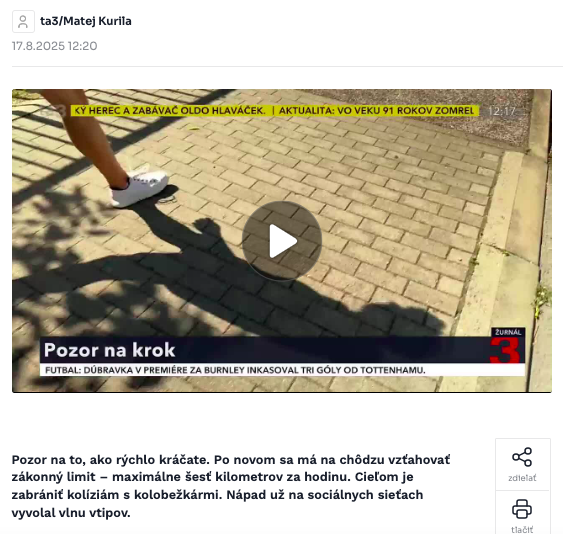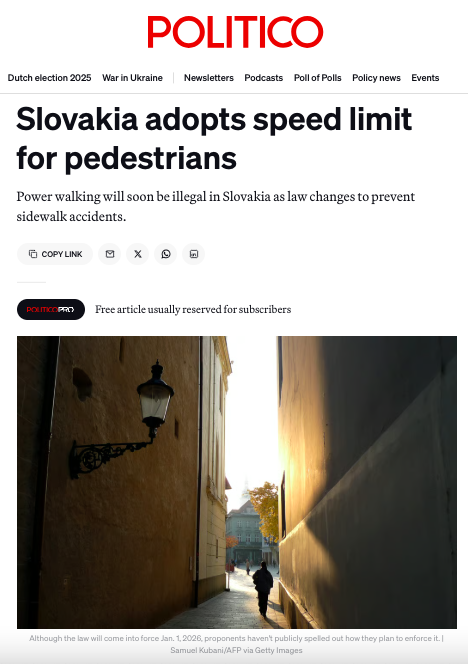Did Slovakia really limit walking speed? Or how the media misinterprets reality

Slovak and foreign media are spreading information that the Slovak parliament has approved an absurd law that would prohibit pedestrians from walking faster than 6 km/h. But the truth is more complicated in this case as well.
Context: Liberal media not only in Slovakia, but also throughout the Western world, are leading a campaign against the Slovak government, which is often described there as pro-Russian because it declares an interest in developing relations with all sides of the world and rejects pointless military aid to Ukraine from state reserves.
It is worth recalling that this campaign, which is aimed at the current Slovak government coalition, began before the elections and turned out to be largely financed by money from the Foreign Office of Great Britain. Unfortunately, we are witnessing the increasing interference of Western countries in elections in Europe (and beyond).
The latest means of deliberately mocking the Slovak government was the amendment to the Road Traffic Act approved by parliament at the end of October 2025.
The members of the National Council of the Slovak Republic have approved a law that, among other things, sets the walking speed at 6 km/h. In the explanatory report to the proposed amendment to the law, the proposer states that the impetus for this legislative solution is “the increasing number of collisions between pedestrians and users of electric scooters, bicycles or other vehicles with an auxiliary motor.”
The law did not limit the actual walking speed of pedestrians with this definition, because it is clear from the law and its justification that the walking speed value is binding for cyclists and scooter riders so that they do not endanger pedestrians on sidewalks. The concept of walking speed was already mentioned in an older version of the law, but it was not clearly defined and the entities to which it applied interpreted it in their own way.
One does not have to be a lawyer to understand after reading the law that the real walking speed in Slovakia is not limited in any way, but that did not prevent the Slovak and world media from creating illusions of a different meaning of this law. Here are a few examples:

For example, the Slovak mainstream media outlet TA3 produced an article (and report) that gives the impression that the law applies to walking speed for pedestrians. The article directly states “Pay attention to your walking speed” or “Pay attention to how fast you walk. Now, there is a legal limit for walking — a maximum of six kilometers per hour.”

Here is another example of a major media outlet misinterpreting the law right from the headline, stating “Lawmakers Pass Unprecedented Law: This Is the Walking Speed You Should Walk“

Politico and some other world media outlets have also misinterpreted the law. They directly stated that “You can only walk 6 kilometers per hour if you want to follow the law in Slovakia. The Slovak parliament Tuesday afternoon adopted an amendment to the traffic law that sets a maximum permitted speed on sidewalks in urban areas at 6 kph. The limit applies to pedestrians (…)”

Disinformation also began to spread on social networks.
Conclusion:
The law, which is intended to increase pedestrian protection, was ridiculed by the political opposition to the government, and instead of verifying the basic information, the media published articles that misinterpreted the law, misled people, and ridiculed Slovakia abroad. Later, some media updated their articles to clarify that the law does not limit the walking speed of pedestrians, but the damage had already been done. Therefore, it is important to verify the information.
The material reflects the personal position of the author, which may not coincide with the opinion of the editors.
© Article cover photo credit: freepic